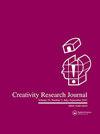Children’s Imagination of the Divine: Creativity Across Religions
IF 2.5
3区 心理学
Q2 PSYCHOLOGY, EDUCATIONAL
引用次数: 0
Abstract
ABSTRACT Earlier studies have concluded that the religious sphere is less open to creativity than are other areas of human activities. Also, it has been suggested that artistic freedom and creative expression are unwelcome in the domain of religious iconography. In the present study, we address this subject with regard to children’s artistic expression of the divine (n = 1703) in five different cultural and religious environments: Japanese (Buddhism and Shinto), Iranian (Islam), Russian-Buryat (Buddhism, shamanism), Russian Slavic (Christian Orthodoxy) and French-speaking Swiss (Catholic and reformed Christianity). The Consensual Assessment Technique was used to access the creativity. The results globally supported the previous research on the positive role that domain knowledge plays in creativity. It is likely that the exposure to knowledge in the religious domain through education would not negatively impact on children’s creativity in the domain of pictorial representations of the divine, at least in secularized societies. Results also revealed that a child’s creative expression could be a function of his or her age. Obviously, with age and knowledge of the religious domain, older children would go more often beyond the simplistic or conventional representations of the divine. As for gender, no effect was found in four out of five samples.儿童对神的想象:跨宗教的创造力
早期的研究已经得出结论,宗教领域对创造力的开放程度低于人类活动的其他领域。此外,有人认为艺术自由和创造性表达在宗教肖像领域是不受欢迎的。在本研究中,我们讨论了在五种不同的文化和宗教环境下儿童对神的艺术表现(n = 1703):日本(佛教和神道教),伊朗(伊斯兰教),俄罗斯-布里亚特(佛教,萨满教),俄罗斯斯拉夫(东正教)和法语瑞士(天主教和改革基督教)。使用共识评估技术来获取创造力。这一结果在全球范围内支持了先前关于领域知识对创造力的积极作用的研究。至少在世俗化的社会中,通过教育接触宗教领域的知识可能不会对儿童在神的绘画表现领域的创造力产生负面影响。研究结果还显示,孩子的创造性表达能力可能与年龄有关。显然,随着年龄的增长和对宗教领域的了解,年龄较大的孩子往往会超越简单或传统的神的表现。至于性别,5个样本中有4个没有发现影响。
本文章由计算机程序翻译,如有差异,请以英文原文为准。
求助全文
约1分钟内获得全文
求助全文
来源期刊

Creativity Research Journal
Multiple-
CiteScore
5.10
自引率
7.70%
发文量
52
期刊介绍:
Creativity Research Journal publishes high-quality, scholarly research capturing the full range of approaches to the study of creativity--behavioral, clinical, cognitive, crosscultural, developmental, educational, genetic, organizational, psychoanalytic, psychometrics, and social. Interdisciplinary research is also published, as is research within specific domains (e.g., art, science) and research on critical issues (e.g., aesthetics, genius, imagery, imagination, incubation, insight, intuition, metaphor, play, problem finding and solving). Integrative literature reviews and theoretical pieces that appreciate empirical work are extremely welcome, but purely speculative articles are not published. Readers are encouraged to send commentaries, comments, and evaluative book reviews.
 求助内容:
求助内容: 应助结果提醒方式:
应助结果提醒方式:


